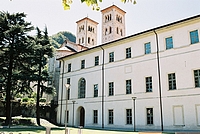Afgelopen week nam ik deel aan de European Conference on Information Management and Evaluation (ECIME 2011) in Como (Italië). Ik presenteerde daar mijn paper ‘Accountability and the reconstruction of the past‘. Het congres richt zich op de manieren waarop met IT, management en evaluatie (toetsing) kan worden omgegaan. Er waren vele interessante tracks en presentaties (plm. 50). Mijn presentatie vond plaats in de track ‘Ensuring quality in digital record and archive services’, met Erik Borglund (Mid Sweden University) als voorzitter.
De toelating van de paper ging (net zoals bij alle wetenschappelijke congressen) via een ‘double blind peer review’, waardoor de organisatie van de conferentie in staat is alleen op basis van de wetenschappelijke kwaliteit van een paper een keuze te maken voor toegang tot het congres. De papers worden anoniem door referenten beoordeeld. Van Academic Conferences (de organisator) begreep ik dat er dit jaar 20 % van de ingezonden abstracts tot de conferentie was toegelaten.
Het abstract dat de paper samenvat luidt als volgt:
‘Many organizations have undergone substantial reorganization in the last decade. They re-engineered their business processes and exchanged proprietary, not integrated applications for more standard solutions. Integration of structured data in relational data bases has improved documentation of business transactions and increased data quality. But almost 90% of the information that organizations manage is unstructured, can not easily be integrated into a traditional database.
Just like structured data, unstructured information in organizations are records, meant and used as evidence for organizational actions and transactions. Governments, courts and other stakeholders are making increasing demands for the trustworthiness of records. This is part of a long-term trend toward defining what accountability means in a digital era.
An analysis of literature of information science, organization science and archival science illustrates that for accountability, reconstruction of the past is essential. Hypothesis of this paper is that for the reconstruction of the past each organization needs (at least) a combination of three mechanisms: enterprise records management, organizational memory and records auditing.
Enterprise records management ensures that records meet the for accountability necessary quality requirements: integrity, authenticity, controllability and historicity. These requirements ensure records that can be trusted. Trusted records enhance the possibility of reconstructing the past. The organizational memory ensures that trusted records are preserved for as long as is necessary to comply to accountability regulations. It provides an information and communication technology infrastructure to (indefinitely) store those records and to keep them accessible. Records auditing audits enterprise records management and organizational memory to assess the possibility to reconstruct past organizational actions and transactions.
These mechanisms ensure that organizations have a documented understanding of: the processing of actions and transactions within business processes; the dissemination of trusted records; the way the organization accounts for the actions and transactions within its business processes; and the reconstruction of actions and transactions from business processes over time.
This understanding is important for the reconstruction of the past in digitized organizations and improve organizational accountability’.
Voor de paper: ECIME-2011 Accountability and the reconstruction of the past
Citatie: G.J. van Bussel, ‘Accountability and the reconstruction of the past’, W. Castelnova, E. Ferrari (red.), Proceedings of the 5th European Conference of Information Management and Evaluation (Academic Publishing Limited, Como 2011), pp. 483-490.


Pingback: Digital Archiving & Compliance - Bevlogen Bespiegelingen